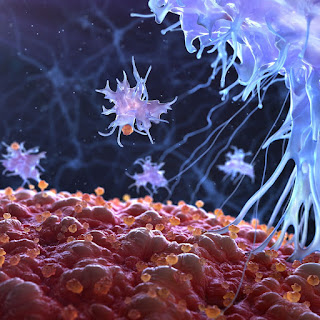A hepatocellular carcinoma (HCC) co-regulatory network exists between chromosome 19 microRNA cluster (C19MC) at 19q13.42, melanoma-A antigens, IFN-γ and p53, promoting an oncogenic role of C19MC that is disrupted by metal ions zinc and nickel. IFN-γ plays a co-operative role whereas IL-6 is antagonistic, each have a major bearing on the expression of HLA molecules on cancer cells. Analysis of Mesenchymal stem cells and cancer cells predicted C19MC modulation of apoptosis in induced pluripotency and tumorigenesis.
Rapid functional impairment of NK cells following tumor entry limits anti-tumor immunity. Gene regulatory network analysis revealed downregulation of TF regulons, over pseudo-time, as NK cells transition to their impaired end state. These included AP-1 complex TF's, Fos, Fosb (19q13.32), Jun, Junb (19p13.13), which are activated during NK cell cytolytic programs and down regulated by interactions with inhibitory ligands. Other down-regulated TF's included Irf8, Klf2 (19p13.11), Myc, which support NK cell activation and proliferation. There were no significantly upregulated TF's suggesting that the tumor-retained NK state arises from the reduced activity of core transcription factors associated with promoting mature NK cell development and expansion.
Innate immune, intra-tumoral, stimulatory dendritic cells (SDCs) and NK cells cluster together and are necessary for enhanced T cell tumor responses. In human melanoma, SDC abundance is associated with intra-tumoral expression of the cytokine producing gene FLT3LG (19q13.33) that is predominantly produced by NK cells in tumors. Computed tomography exposes patients to ionizing X-irradiation. Determined trends in the expression of 24 radiation-responsive genes linked to cancer, in vivo, found that TP53 and FLT3LG expression increased linearly with CT dose.
Undifferentiated embryonal sarcoma of the liver displays high aneuploidy with recurrent alterations of 19q13.4 that are uniformly associated with aberrantly high levels of transcriptional activity of C19MC microRNA. Further, TP53 mutation or loss was present with all samples that also display C19MC changes. The 19q13.4 locus is gene-poor with highly repetitive sequences. Given the noncoding nature and lack of an obvious oncogene, disruption of the nearby C19MC regulatory region became a target for tumorigenesis.
The endogenous retroviral, hot-spot deletion rate at 19p13.11-19p13.12 and 19q33-19q42 occurs at double the background deletion rate. Clustered in and around these regions are many gene families including KIR, Siglec, Leukocyte immunoglobulin-like receptors and cytokines that associate important NK gene features to proximal NK genes that were overrepresented in a meta analysis of blood pressure.
Endogenous retroviruses that invite p53 and its transcriptional network, at retroviral hot-spots, suggest that lymphocyte progenitors, such as ILC's and expanded, NK cells are synergistically responsive to transcription from this busy region including by the top differentially expressed blood pressure genes MYADM, GZMB, CD97, NKG7, CLC, PPP1R13L , GRAMD1A as well as (RAS-KKS) Kallikrein related peptidases to educate early and expanded NK cells that shape immune responses.





